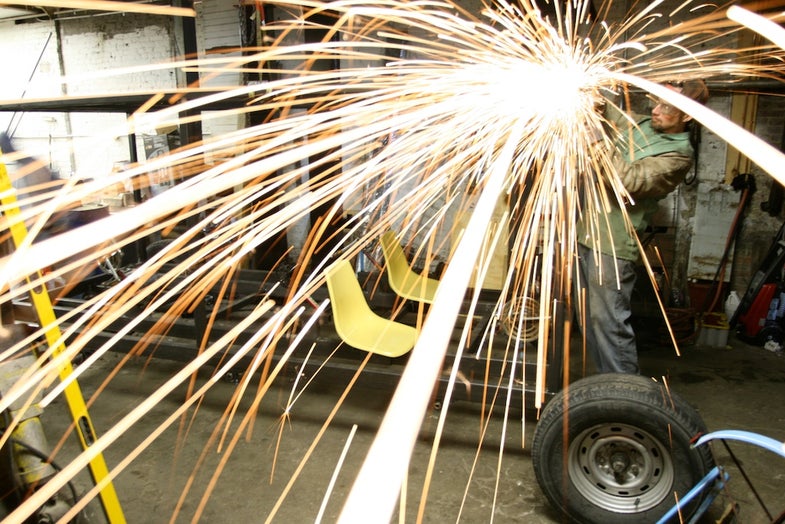Tool School: Let the Sparks Fly
Here's how to master the angle grinder, a screaming tool that, for better or worse, can wreak havoc on metal

While Letterman’s Grinder Girls proved that the best use for an angle grinder is to let beautiful women in bondage gear make sparks, it’s actually one of the more versatile tools you can keep in the shop. Of course, with great power comes great responsibility: Get too trigger happy and you can quickly destroy your project and your fingers. Here’s your crash course to wielding one of the more badass of the handheld power tool genre.
What: Angle Grinder
Why: There are few faster ways to abrasively remove material from steel, expecially with something handheld.
Where: $20 at Harbor freight, $100 for a name brand at Home Depot, and $200 for a sweet Metabo like mine. A Harbor Freight grinder literally caught fire in my hands. A series of DeWalt grinders from Home Depot lasted for a while, but eventually broke again and again and again. I’ve owned my Metabo for years and I can run it all day without discomfort because it vibrates so little. You get what you pay for. That said, you can destroy 10 Harbor Freight grinders before you’ve paid for a Metabo. If you are only going to have one grinder in your ship, I’ve found the 4.5-inch size to be the most useful.
When: Really, as infrequently as possible. There are better, quieter, and less messy ways to remove metal, but when you need one, you need one. They are ideal for de-burring, rounding corners, some shaping, and even sharpening drill bits when you are in the field. They are indispensable for fixing fitment issues when you go to assemble and weld.
Who: You, if you ever work with metal at all.

Angle Grinder
Angle Grinding 101
As with power tools, always wear the proper safety equipment and pay attention to your environment. Wear safety glasses and hearing protection. Sparks fly everywhere and don’t mix well with eyeballs: Strongly consider wearing a flip down face shield.
The angle grinder is about as simple as a tool can get. There is a housing, a handle, and a motor that spins as fast as 11,000 rpm. To the shaft of that motor, wheels of various types—almost all abrasives of one kind of another—are attached.
The angle grinder is great for doing some quick shaping and metal removal. I often use it to roughly round off corners and remove burrs from shearing or cutting. Just as you would with a sander on wood, keep it moving and try not to dig in. It can remove a lot of metal in a hurry, and if you are not careful, you’ll make a mess of your workpiece. Go lightly.
If you find that you are using the angle grinder to remove a large amount of material, it is time to rethink what you are doing. There are other ways to remove a lot of metal, and almost all of them are cleaner and quicker than the angle grinder. Look at plasma cutting, oxy-acetylene cutting and a band saw or port-a-band.
Advanced Angle Grinding
Grinding wheels are just the beginning. Take a look at flap wheels (not worth the money in most cases in my opinion, but still neat), cutoff wheels, flat sanding discs with a backing wheel and wire wheels.
Cutoff wheels can make quick work of small cuts, especially those where it is impractical to get a cutting torch or band saw into position. I often use cutoff wheels to dig myself out of the mess if I have some tack welds that need to be cut out so that I can adjust something.
Sanding discs and the corresponding backing pad are the most useful application of an angle grinder, in my opinion, and spend far more time on mine than do grinding wheels. The backing pad will help you to make a flat surface with your grinding and the sanding discs are far less aggressive than a grinding wheel, leaving a smoother finish.
A lot of people love flap wheels. They behave like a refined version of the flat sanding discs and are undeniably nice. However, in my experience, they never last very long, and they are far more expensive.
Wire Wheels on the angle grinder are great for the brave among you. Hundreds of little tiny wires attached to a wheel spinning at thousands of RPMs—eventually a few come loose and become projectiles that have no problem penetrating cotton shirts and even jeans. I use them from time to time out of necessity and/or stupidity to remove paint, galvanization and rust. I was removing under coating from an old car body with a wire wheel on a Harbor Freight grinder when the grinder caught fire. I far prefer the cupped wire wheels, both for their effectiveness and their ability to stay together.
There are also some wheels out there to cut various types of masonry, making the angle grinder useful for at least a little more than just metal.